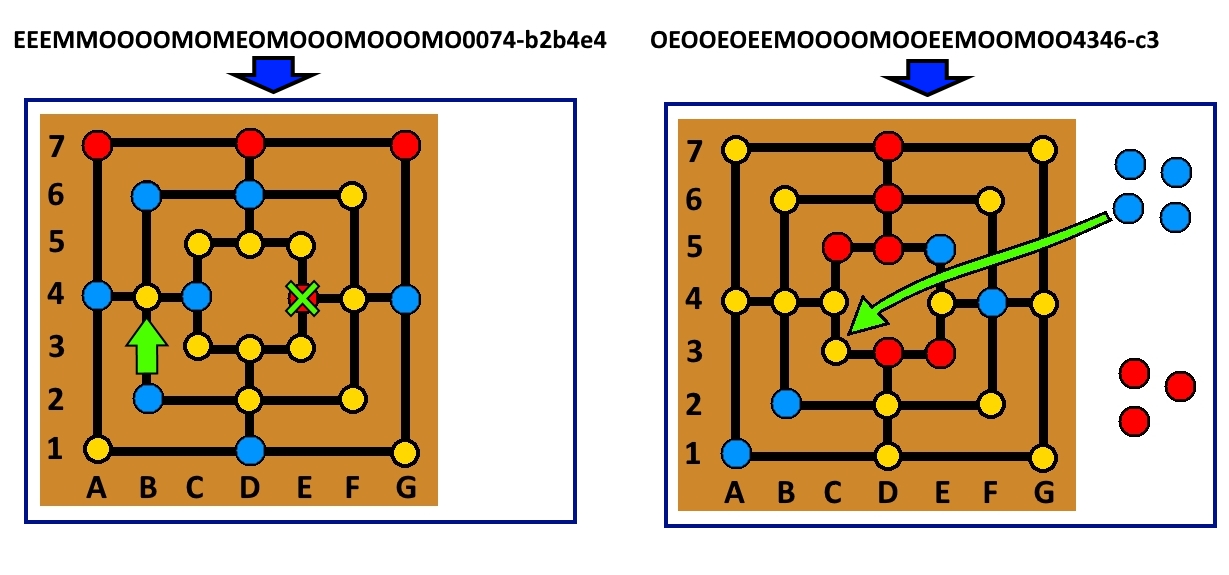Nine Men's Morris Good Moves Dataset
If you use these datasets as part of any work, please cite it as:
The accepted version of this work (post-print) can be found here (top of the page)
These datasets are available on NNMM's GitHub page: https://github.com/AGalassi/NNMM/tree/master/datasets
Brief history of these datasets
This data sets are collections of states of the game Nine Men's Morris, which have been created with the purpose to apply machine learning to train softwares to play to the game, and to test their performances.
- The Good Moves Dataset (also called Matches Dataset) contains couples state-move and can be used for train systems.
- The State Dataset contains only game states and can be used for testing purposes.
These datasets have been created by Andrea Galassi, as part of his master thesis in Computer Science Engineering ("Ingegneria Informatica", in italian) and as part of a successive work.
Please feel free to contact him (a.galassi *at* unibo.it) or his thesis supervisors (Paola Mello, paola.mello *at* unibo.it, Federico Chesani federico.chesani *at* unibo.it) for further questions.
For further information, the thesis is available here: Symbolic versus sub-symbolic approaches: a case study on training Deep Networks to play Nine Men’s Morris game.
Good Moves Dataset (Matches Dataset)
The dataset consist of 100,154 game states and as many good moves elaborated by an Artificial Intelligence for the game of Nine Men's Morris.
None of the states in the dataset is symmetric to any other, therefore anyone can handle the symmetries as he/she prefers.
If all the symmetric states are explored, the dataset can reach 1,628,673 pairs.
The dataset contains states both reachable and unreachable during a normal match, decreasing the probability of reaching a training state during a testing match. The moves contained in it could be different from the optimal one, however, it constitutes a good knowledge base, from which other AI system can learn to play the game.
All the data have been generated making play an Artificial Intelligence called Deep Mill against other artificial intelligence and gathering the choices made by Deep Mill during the games.
Three version of the dataset are available:
- The COMPLETE DATASET contains all the data, without the symmetric pairs.
- The GAMING DATASET do not contains data coming from a regular match starting with an empty board. Therefore it contains states which are more unlikely to be reached during a match.
- The EXPANDED DATASET contains all the data and the symmetric pairs.
Reachable States Dataset
The dataset consist of 2,085,613 states which are reachable through a finite sequence of legal moves starting from the initial empty board configurations. It has been generated exploring the space of the game states applying random choices from a reachable configurations.
None of the states contained in this dataset is present in the Good Moves Dataset.
- The COMPLETE STATES DATASET contains all the states, without the symmetric ones.
- The EXTENDED STATES DATASET contains all the states. with the symmetric ones.
Data format
The dataset does not distinction between black and white checkers but only between player checkers and enemy ones. An entry of the dataset consist of a string of 31 to 35 characters:
- The first 24 characters describe the board state with a letter representing the state of each position: O if the position is empty, M (Mine) if there is a checker of the player and E (Enemy) if there is an opponent one. The position are represented in order as they appear from left to right and from top to bottom
- A sequence of 4 numbers completes the state representation, where the first two numbers represent, respectively, the number of checkers that the player has in its hands and the ones that his adversary has; the last two represent, in the same order, the number of checker that the players have on the board.
- An hyphen divides the game state from the move description, which is written as pairs of coordinates letter-number; the meaning of each coordinate depends on the game phase: the parts of the move are written (if present) in the order FROM, TO and REMOVE.


NNMM: Neural Nine Men's Morris
This dataset has been used to train a neural networks system called Neural Nine Men's Morris to play the game, without inserting symbolic knowledge about the game rules.
After training the system has been tested on the whole expanded dataset (therefore considering any symmetric state) and the outcome is:
- The system has learnt the rules (99% of cases the chosen move is legal)
- The system has an accuracy of the whole move of about 37%
For more information about neural networks, NNMM and its testing, see Neural Nine Men's Morris.
Useful free resurces
- Can Deep Networks Learn to Play by the Rules? A Case Study on Nine Men's Morris (accepted version available at the bottom of the page)
- Symbolic versus sub-symbolic approaches: a case study on training Deep Networks to play Nine Men’s Morris game
- Neural Nine Men's Morris
- Nine Men's Morris Annual Challenge
- DeepMill
